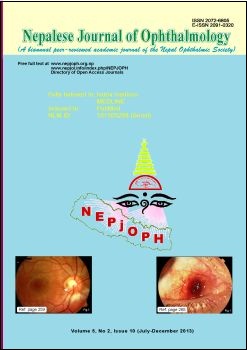Comparison between limbal (von Noorden) and para limbal (Santiago) conjunctival incisions for adjustable recessions of horizontal recti
DOI:
https://doi.org/10.3126/nepjoph.v5i2.8732Keywords:
adjustable recession, conjunctival incision, horizontal rectus, strabismusAbstract
Introduction: Both limbal and para limbal conjunctival incisions are routinely used in strabismus surgery with comparable results however their outcome has not been compared while using adjustable sutures.
Objective: To compare limbal (von Noorden) and para limbal (Santiago) conjunctival incisions for adjustable recessions of horizontal recti.
Subjects and methods: Uniocular adjustable recessions (with conventional non adjustable resection) in 24 appropriate patients were performed according to standard slip knot technique. The patients were assigned to the two groups after obtaining an informed consent using systematmic randomization. Twelve patients in first group received the von Noorden incision with bare sclera closure and 12 in the second group received the Santiago’s modification of Swan incision with deferred closure. The surgeries were performed by a single surgeon and the adjustments performed after 24 hours. The incisions were studied on the established subjective (pain) and objective (hyperaemia, chemosis, discharge and gap in incision) variables at follow ups of 1st day post adjustment, 2 weeks and 12 weeks.
Statistics: ‘Repeated Measures Anova’ test was used for statistical analysis. A p value <0.05 was considered statistically significant.
Results: The limbal incision was superior to the paralimbal incision on both objective and subjective criteria by ‘Repeated Measures Anova’ test.
Conclusion: We recommend using limbal incision and avoiding para limbal incisions while performing adjustable recessions.
Nepal J Ophthalmol 2013; 5(10): 220-225
Downloads
Downloads
Published
How to Cite
Issue
Section
License
This license enables reusers to copy and distribute the material in any medium or format in unadapted form only, for noncommercial purposes only, and only so long as attribution is given to the creator.




